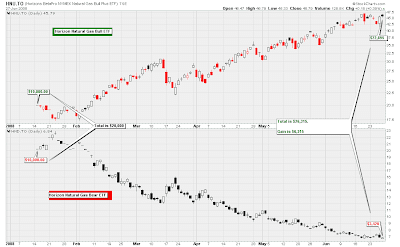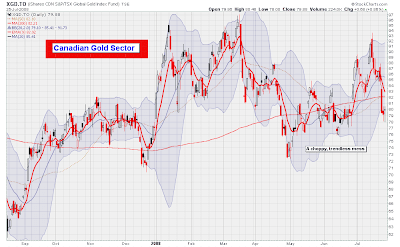As I have mentioned before on this site, Horizon
ETFs are a type of investment that allow traders to go long or short a particular market with 200% daily exposure. For example, this organization has two
ETFs that track natural gas:
HNU-which stands for
Horizon Natural gas
Up
HND-which stands for
Horizon Natural gas
Down
This means that if in a given day, the price of natural gas rises by, say, 2%, then
HNU should rise by about 4%, and
HND should fall by about 4%.
Both of these
ETFs were launched in mid-January 2008, with a price of $20.00 per share. What I was curious in finding out is what if you had purchased both of these
ETF right from the start and held them to today. At first I thought that purchasing equal amounts of both
ETFs would create a perfect hedge, with the gain of one fund offsetting the other. However, this was not the case.
Below is a chart showing
HNU on the top panel, and
HND on the bottom panel going back until the date these funds were launched:

If you click on the above image and read the annotations, you will see that if you had invested $10,000 into each fund on inception date, you would actually have produced a nice profit. The two funds, in other words, did not cancel each other out.
The reason for this is that as the price of natural gas rose, the balance of
HNU was growing larger, and the balance of
HND was becoming smaller. As this trend continued, the percentage change had a larger dollar value to work on with
HNU and a smaller balance to work on with
HND.
Put another way, the bull
ETF has unlimited compounding potential upwards, but the bear
ETF cannot reach zero, and its chart becomes what is know as asymptotic as it approaches the X axis of the chart.
Believe it or not, knowing this can be useful in the real world. Let's say you have $10,000 worth of energy stocks in your portfolio, and you feel that perhaps now you want to take out some insurance against a potential market correction. To do this you would buy $5,000 worth of
HED, which will rise 2% for every 1% the Canadian energy sector falls.
At this moment your $10,000 position is hedged. But if energy stocks continue to rise, your insurance in
HED will start eroding, which will mean that to remain hedged you will need to buy increasing amounts of
HED to maintain the hedge. Conversely, if a correction in energy does in fact materialize, then you would become over hedged if you do not trim back your exposure to
HED as the correction continues.
I still think these
ETFs are an innovative product, and, luckily, a new set of these type of
ETFs have just been released:
•S&P 500 Bull Plus
ETF•S&P 500 Bear Plus
ETF•NASDAQ-100 Bull Plus
ETF•NASDAQ-100 Bear Plus
ETF•
MSCI Emerging Markets Bull Plus
ETF•
MSCI Emerging Markets Bear Plus
ETF•U.S. Dollar Bull Plus
ETF•U.S. Dollar Bear Plus
ETF•U.S. 30-year Bond Bull Plus
ETF•U.S. 30-year Bond Bear Plus
ETF
 About 1 year ago, I read Schiff's book, Crash Proof. In it, he explains his outlook on the US economy, the housing market, the US dollar, and gold. Looking back now at this book, I am amazed at the clarity of wisdom, and the accuracy of his predictions. Most interesting of all, so far only half of his predications have come to pass, with the other half still in the pipeline, in my view.
About 1 year ago, I read Schiff's book, Crash Proof. In it, he explains his outlook on the US economy, the housing market, the US dollar, and gold. Looking back now at this book, I am amazed at the clarity of wisdom, and the accuracy of his predictions. Most interesting of all, so far only half of his predications have come to pass, with the other half still in the pipeline, in my view.







![[Most Recent Quotes from www.kitco.com]](http://www.kitconet.com/images/live/s_gold.gif)
![[Most Recent Quotes from www.kitco.com]](http://www.kitconet.com/images/live/s_silv.gif)

